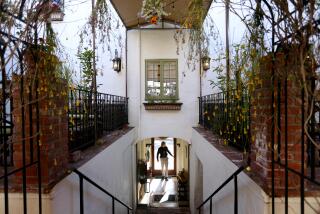Mission San Diego de Alcala : Diocese Plan to Build Over Ruins Advances
- Share via
In a tentative conclusion to a 10-year-old controversy, the Roman Catholic Diocese of San Diego would be allowed to build above the 200-year-old ruins of the Mission San Diego de Alcala under a compromise plan backed by a city panel and now under review by the City Council.
Under the arrangement, the diocese can build an 8,000-square-foot, multipurpose hall first proposed in 1978 for the Mission Valley spot. But the $800,000 building would rest on a platform kept above ground by concrete pillars, making possible excavations.
Nothing of Value Found
The Mission’s present-day parish has argued that a University of San Diego team, which completed its 18-year excavation of the site last year, found that neither church ruins nor other historical artifacts lay directly below the ground in question.
But the city’s Historical Site Board has repeatedly delayed granting construction permits out of concern for the ruins, which are a national historic landmark. The mission, the first established in California by Father Junipero Serra, was founded in 1769 and moved later to its current site.
As part of the new Site Board compromise, which still must go before the City Council, an archeologist selected jointly by the diocese and the city will oversee the excavation of the approximately 20 holes for the concrete pillars, or caissons.
A crawl space between the ground and the building’s platform would be filled with loose sand or gravel, said diocese attorney Donald Worley.
“We won’t just pour concrete on the ground. We’re going to excavate down to sterile soil, and it will be under the watchful eye of the architect,” Worley said.
“The university people say there’s nothing left, and the caisson holes should uncover anything still there. Generally it’s practice to preserve some access to a site in perpetuity, although it will be closed off for the foreseeable future.”
Used Up Time
Worley said the diocese struck the bargain with the city because the Site Board had used up its legally permissible time for stalling. “Once time ran out, we had a legal right to draw the building permit, and I believe the city attorney recognized that, although some concerned were not happy about it.
“We could have built right on the ground, but in the spirit of compromise we agreed to this,” he said.
The new building, which would join half a dozen parish structures nearby, would be used for classes, meetings, social gatherings and other functions for the more than 1,000 Mission worshipers and for tourists, said diocese business manager Barry Crane.
Ron Buckley, secretary of the Site Board, said the National Park Service, which has some responsibility for the Mission, considered the compromise “the minimum acceptable” protection for the site. He added that he believes some artifacts remain buried there.
“The diocese compromised because we’re going forward with a tougher new ordinance,” Buckley said. The new rules, to be considered next month, would give the Site Board power to deny building permits, not just delay them.
Some academics remain unhappy with the plan.
“I find it totally unacceptable. The archeologists generally feel that it’s an acceptable mitigation, but you’re still building a monstrous development on top of ruins. It wasn’t just a mission but a blacksmith shop and agricultural storage areas, which could show it as the gigantic economic enterprise it was,” said Raymond Starr, San Diego State University history professor.
“That will be the end of that as a historical site. You can’t make me believe that those fragile walls and floors would survive tons of dirt and gravel, whether it’s loose or not,” he said.
“This is where the first irrigation system was established, where crops like citrus fruits and grapes and olives were introduced. It’s a West Coast version of Jamestown and Plymouth Rock.
“No one would think of building over Plymouth Rock,” Starr said.
More to Read
Sign up for Essential California
The most important California stories and recommendations in your inbox every morning.
You may occasionally receive promotional content from the Los Angeles Times.













